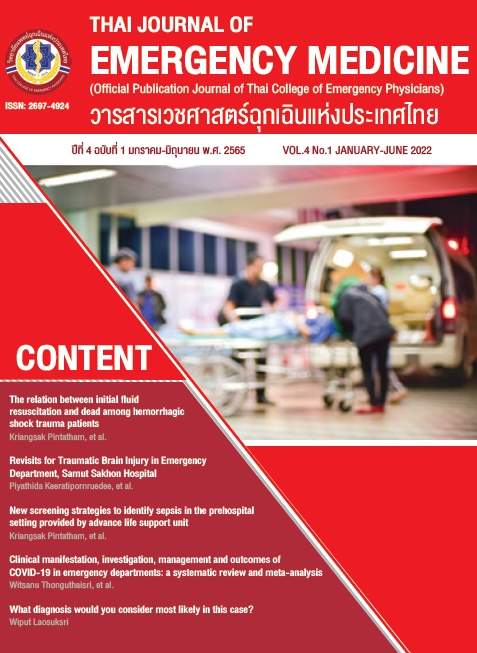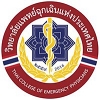New Screening strategies to identify sepsis in the prehospital setting provided by Advance life support unit
Keywords:
sepsis, infection, emergency medical serviceAbstract
Background: Sepsis is one of the leading causes of death and disability in Thailand. Sepsis is a difficult condition to diagnose. There are many types of diagnostic tools available today. Each tool has difficulty to use and have different sensitivity and specificity for screening out-of-hospital sepsis. But none of them was recognized as the best tool.
Objective: To study the relationship between factors and the diagnosis of out-of-hospital sepsis delivered by advance life support unit and to take the factors that affect the diagnosis to create a new approach for screening patients with out-of-hospital sepsis.
Method: A Retrospective cohort study was conducted from January 1, 2020 to January 31, 2021 in patients suspected sepsis compared with final diagnosis. The data were collected from medical records during transport and digital medical records. Then, using the data to analyze the relationship of factors affecting the diagnosis sepsis.
Results: Of 285 patients, 129 patients were found to have sepsis. Risk factors of out of hospital sepsis with statistical significance are systolic blood pressure≤ 90 mmHg (OR 4.397, 95%CI 2.106-90178, p<0.001), Pulse oximetry≤ 94% (OR 2.652, 95%CI 1.551-4.445, p<0.001),Blood glucose>180mg/dL (OR 3.812, 95%CI 1.677-8.663, p=0.001) and Glasgow Coma Scale≤14 (OR 1.866, 95%CI 1.103-3.159, p=0.020).
Conclusion: Factors affecting the diagnosis of patients with out-of-hospital sepsis transport by advance life support unit are systolic blood pressure≤ 90 mmHg, Pulse oximetry≤ 94%, Blood glucose>180mg/dL and Glasgow Coma Scale≤14 .
References
Levy MM, Evans LE, Rhodes A. The surviving sepsis campaign bundle: 2018 update. Intensive Care Medicine. 2018;44(6):925–8.
Dugar S, Choudhary C, Duggal A. Sepsis and septic shock: Guideline-based management. Cleveland Clinic Journal of Medicine. 2020;87(1):53–64.
Studnek JR, Artho MR, Garner CL, Jones AE. The impact of emergency medical services on the ED care of severe sepsis. The American Journal of Emergency Medicine. 2012;30(1):51–6.
Jones J, Lawner BJ. Prehospital sepsis care. Emergency Medicine Clinics of North America. 2017;35(1):175–83.
Borrelli G, Koch E, Sterk E, Lovett S, Rech MA. Early recognition of sepsis through Emergency Medical Services pre-hospital screening. The American Journal of Emergency Medicine. 2019;37(8):1428–32.
Lane DJ, Wunsch H, Saskin R, Cheskes S, Lin S, Morrison LJ, et al. Screening strategies to identify sepsis in the prehospital setting: A validation study. Canadian Medical Association Journal. 2020;192(10).
Lane D, Ichelson RI, Drennan IR, Scales DC. Prehospital management and identification of sepsis by Emergency Medical Services: A systematic review. Emergency Medicine Journal. 2016;33(6):408–13.
Liu S-jia, Hu H. Comparison of six scoring systems for predicting the mortality of severe sepsis patients in the emergency department. The American Journal of Emergency Medicine. 2018;36(5):902–4.
Polito CC, Isakov A, Yancey AH, Wilson DK, Anderson BA, Bloom I, et al. Prehospital recognition of severe sepsis: Development and validation of a novel Ems Screening Tool. The American Journal of Emergency Medicine. 2015;33(9):1119–25.
Haydar S, Spanier M, Weems P, Wood S, Strout T. Comparison of QSOFA score and SIRS criteria as screening mechanisms for emergency department sepsis. The American Journal of Emergency Medicine. 2017;35(11):1730–3.
Jouffroy R, Saade A, Ellouze S, Carpentier A, Michaloux M, Carli P, et al. Prehospital triage of septic patients at the SAMU Regulation: Comparison of qSOFA, MRST, Mews and PRESEP scores. The American Journal of Emergency Medicine. 2018;36(5):820–4.
Usman OA, Usman AA, Ward MA. Comparison of Sirs, qSOFA, and news for the early identification of sepsis in the emergency department. The American Journal of Emergency Medicine. 2019;37(8):1490–7.
Smyth MA, Gallacher D, Kimani PK, Ragoo M, Ward M, Perkins GD. Derivation and internal validation of the screening to enhance prehospital identification of sepsis (sepsis) score in adults on arrival at the Emergency Department. Scandinavian Journal of Trauma, Resuscitation and Emergency Medicine. 2019;27(1).
Usul E, Korkut S, Kayipmaz AE, Halici A, Kavalci C. The role of the Quick Sequential Organ Failure Assessment Score (qsofa) and modified early warning score (MEWS) in the pre-hospitalization prediction of sepsis prognosis. The American Journal of Emergency Medicine. 2021;41:158–62.
Ruangsomboon O, Boonmee P, Limsuwat C, Chakorn T, Monsomboon A. The utility of the Rapid Emergency Medicine Score (REMS) compared with SIRS, qSOFA and news for predicting in-hospital mortality among patients with suspicion of sepsis in an emergency department. BMC Emergency Medicine. 2021;21(1).
Silcock DJ, Corfield AR, Gowens PA, Rooney KD. Validation of the National Early Warning score in the prehospital setting. Resuscitation. 2015;89:31–5.
Roney JK, Whitley BE, Maples JC, Futrell LS, Stunkard KA, Long JAD. Modified early warning scoring (MEWS): Evaluating the evidence for tool inclusion of sepsis screening criteria and impact on mortality and failure to rescue. Journal of Clinical Nursing. 2015;24(23-24):3343–54.
Shu E, Ives Tallman C, Frye W, Boyajian JG, Farshidpour L, Young M, et al. Pre-hospital qsofa as a predictor of sepsis and mortality. The American Journal of Emergency Medicine. 2019;37(7):1273–8.
Dorsett M, Kroll M, Smith CS, Asaro P, Liang SY, Moy HP. QSOFA has poor sensitivity for prehospital identification of severe sepsis and septic shock. Prehospital Emergency Care. 2017;21(4):489–97.
Wallgren UM, Castrén M, Svensson AEV, Kurland L. Identification of adult septic patients in the prehospital setting. European Journal of Emergency Medicine. 2014;21(4):260–5.
Bayer O, Schwarzkopf D, Stumme C, Stacke A, Hartog CS, Hohenstein C, et al. An early warning scoring system to identify septic patients in the prehospital setting: The PRESEP score. Academic Emergency Medicine. 2015;22(7):868–71.
Evans L, Rhodes A, Alhazzani W, Antonelli M, Coopersmith CM, French C, et al. Surviving sepsis campaign: International guidelines for management of sepsis and septic shock 2021. Intensive Care Medicine. 2021;47(11):1181–247.
Wallgren UM, Sjölin J, Järnbert-Pettersson H, Kurland L. The predictive value of variables measurable in the ambulance and the development of the predict sepsis screening tools: A prospective cohort study. Scandinavian Journal of Trauma, Resuscitation and Emergency Medicine. 2020;28(1).
Adegboro BA, Imran J, Abayomi SA, Sanni EO, Biliaminu SA. Recent advances in the pathophysiology and management of sepsis: A Review. African Journal of Clinical and Experimental Microbiology. 2021;22(2):133–45.

Downloads
Published
How to Cite
Issue
Section
Categories
License
Copyright (c) 2022 Thai Collage of Emergency Physicians

This work is licensed under a Creative Commons Attribution-NonCommercial-NoDerivatives 4.0 International License.
บทความที่ได้รับตีพิมพ์ในวารสารเวชศาสตร์ฉุกเฉินแห่งประเทศไทย ถือเป็นเป็นลิขสิทธิ์ของ วิทยาลัยแพทย์เวชศาสตร์ฉุกเฉินแห่งประเทศไทย
กรณีที่บทความได้รับการตีพิมพ์ในวารสารเวชศาสตร์ฉุกเฉินแห่งประเทศไทยแล้ว จะตีพิมพ์ในรูปแบบอิเล็กทรอนิกส์ ไม่มีสำเนาการพิมพ์ภายหลังหนังสือเผยแพร่เรียบร้อยแล้ว ผู้นิพนธ์ไม่สามารถนำบทความดังกล่าวไปนำเสนอหรือตีพิมพ์ในรูปแบบใดๆ ที่อื่นได้ หากมิได้รับคำอนุญาตจากวารสารเวชศาสตร์ฉุกเฉินแห่งประเทศไทย



